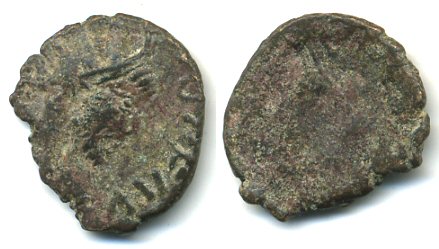
Crude unreadable inscriptions, Tetricus facing right / Mirror image in incuse. 17mm, 1.6 grams.
Scarce.
A brockage in ancient numismatics is a minting error that occurs when a freshly struck coin sticks to the die and then impresses its design in reverse onto the next blank flan. The result is a coin with a normal design on one side and an incuse, mirror-image impression of the same design on the other. Brockages are relatively rare and are prized by collectors, as they provide direct evidence of ancient minting techniques.
Ancient barbarous radiates seem to have been produced between the reigns of Claudius II and ca.274 AD, when Aurelian banned the circulation of these small imitative bronzes throughout the Empire. It is likely that at least some of the barbarous radiates were produced after 274 AD all the way into the early 280's. The value of the barbarous imitations was almost certainly not equal to their official counterparts - they probably saw only local limited circulation, and fulfilled the role of token coinage in times of an acute coin shortage.
